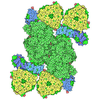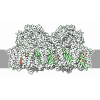[English] 日本語
 Yorodumi
Yorodumi- PDB-7n8o: High-resolution structure of photosystem II from the mesophilic c... -
+ Open data
Open data
- Basic information
Basic information
| Entry | Database: PDB / ID: 7n8o | ||||||
|---|---|---|---|---|---|---|---|
| Title | High-resolution structure of photosystem II from the mesophilic cyanobacterium, Synechocystis sp. PCC 6803 | ||||||
 Components Components |
| ||||||
 Keywords Keywords | PHOTOSYNTHESIS / Photosystem II / Cyanobacteria / Synechocystis 6803 / Mesophile / CyanoQ | ||||||
| Function / homology |  Function and homology information Function and homology informationplasma membrane-derived thylakoid photosystem II / photosystem II oxygen evolving complex / photosystem II assembly / oxygen evolving activity / photosystem II stabilization / photosystem II reaction center / photosystem II / oxidoreductase activity, acting on diphenols and related substances as donors, oxygen as acceptor / photosynthetic electron transport chain / photosystem II ...plasma membrane-derived thylakoid photosystem II / photosystem II oxygen evolving complex / photosystem II assembly / oxygen evolving activity / photosystem II stabilization / photosystem II reaction center / photosystem II / oxidoreductase activity, acting on diphenols and related substances as donors, oxygen as acceptor / photosynthetic electron transport chain / photosystem II / response to herbicide / extrinsic component of membrane / chlorophyll binding / plasma membrane-derived thylakoid membrane / photosynthetic electron transport in photosystem II / : / phosphate ion binding / photosynthesis, light reaction / photosynthesis / respiratory electron transport chain / manganese ion binding / electron transfer activity / protein stabilization / iron ion binding / heme binding / calcium ion binding / metal ion binding / identical protein binding Similarity search - Function | ||||||
| Biological species |  | ||||||
| Method | ELECTRON MICROSCOPY / single particle reconstruction / cryo EM / Resolution: 1.93 Å | ||||||
 Authors Authors | Gisriel, C.J. / Brudvig, G.W. | ||||||
| Funding support |  United States, 1items United States, 1items
| ||||||
 Citation Citation |  Journal: Proc Natl Acad Sci U S A / Year: 2022 Journal: Proc Natl Acad Sci U S A / Year: 2022Title: High-resolution cryo-electron microscopy structure of photosystem II from the mesophilic cyanobacterium, sp. PCC 6803. Authors: Christopher J Gisriel / Jimin Wang / Jinchan Liu / David A Flesher / Krystle M Reiss / Hao-Li Huang / Ke R Yang / William H Armstrong / M R Gunner / Victor S Batista / Richard J Debus / Gary W Brudvig /  Abstract: Photosystem II (PSII) enables global-scale, light-driven water oxidation. Genetic manipulation of PSII from the mesophilic cyanobacterium sp. PCC 6803 has provided insights into the mechanism of ...Photosystem II (PSII) enables global-scale, light-driven water oxidation. Genetic manipulation of PSII from the mesophilic cyanobacterium sp. PCC 6803 has provided insights into the mechanism of water oxidation; however, the lack of a high-resolution structure of oxygen-evolving PSII from this organism has limited the interpretation of biophysical data to models based on structures of thermophilic cyanobacterial PSII. Here, we report the cryo-electron microscopy structure of PSII from sp. PCC 6803 at 1.93-Å resolution. A number of differences are observed relative to thermophilic PSII structures, including the following: the extrinsic subunit PsbQ is maintained, the C terminus of the D1 subunit is flexible, some waters near the active site are partially occupied, and differences in the PsbV subunit block the Large (O1) water channel. These features strongly influence the structural picture of PSII, especially as it pertains to the mechanism of water oxidation. | ||||||
| History |
|
- Structure visualization
Structure visualization
| Movie |
 Movie viewer Movie viewer |
|---|---|
| Structure viewer | Molecule:  Molmil Molmil Jmol/JSmol Jmol/JSmol |
- Downloads & links
Downloads & links
- Download
Download
| PDBx/mmCIF format |  7n8o.cif.gz 7n8o.cif.gz | 1.2 MB | Display |  PDBx/mmCIF format PDBx/mmCIF format |
|---|---|---|---|---|
| PDB format |  pdb7n8o.ent.gz pdb7n8o.ent.gz | 1 MB | Display |  PDB format PDB format |
| PDBx/mmJSON format |  7n8o.json.gz 7n8o.json.gz | Tree view |  PDBx/mmJSON format PDBx/mmJSON format | |
| Others |  Other downloads Other downloads |
-Validation report
| Summary document |  7n8o_validation.pdf.gz 7n8o_validation.pdf.gz | 8.2 MB | Display |  wwPDB validaton report wwPDB validaton report |
|---|---|---|---|---|
| Full document |  7n8o_full_validation.pdf.gz 7n8o_full_validation.pdf.gz | 8.8 MB | Display | |
| Data in XML |  7n8o_validation.xml.gz 7n8o_validation.xml.gz | 251.5 KB | Display | |
| Data in CIF |  7n8o_validation.cif.gz 7n8o_validation.cif.gz | 333.7 KB | Display | |
| Arichive directory |  https://data.pdbj.org/pub/pdb/validation_reports/n8/7n8o https://data.pdbj.org/pub/pdb/validation_reports/n8/7n8o ftp://data.pdbj.org/pub/pdb/validation_reports/n8/7n8o ftp://data.pdbj.org/pub/pdb/validation_reports/n8/7n8o | HTTPS FTP |
-Related structure data
| Related structure data |  24239MC  7rcvC M: map data used to model this data C: citing same article ( |
|---|---|
| Similar structure data |
- Links
Links
- Assembly
Assembly
| Deposited unit | 
|
|---|---|
| 1 |
|
- Components
Components
-Photosystem II ... , 17 types, 34 molecules AaBbCcDdHhIiJjKkLlMmOoRrTtUuXx...
| #1: Protein | Mass: 39744.117 Da / Num. of mol.: 2 / Source method: isolated from a natural source Source: (natural)  Strain: PCC 6803 / Kazusa / References: UniProt: P16033, photosystem II #2: Protein | Mass: 55954.355 Da / Num. of mol.: 2 / Source method: isolated from a natural source Source: (natural)  Strain: PCC 6803 / Kazusa / References: UniProt: P05429 #3: Protein | Mass: 50344.723 Da / Num. of mol.: 2 / Source method: isolated from a natural source Source: (natural)  Strain: PCC 6803 / Kazusa / References: UniProt: P09193 #4: Protein | Mass: 39519.238 Da / Num. of mol.: 2 / Source method: isolated from a natural source Source: (natural)  Strain: PCC 6803 / Kazusa / References: UniProt: P09192, photosystem II #7: Protein | Mass: 7120.404 Da / Num. of mol.: 2 / Source method: isolated from a natural source Source: (natural)  Strain: PCC 6803 / Kazusa / References: UniProt: P14835 #8: Protein/peptide | Mass: 4338.119 Da / Num. of mol.: 2 / Source method: isolated from a natural source Source: (natural)  Strain: PCC 6803 / Kazusa / References: UniProt: Q54697 #9: Protein/peptide | Mass: 3976.687 Da / Num. of mol.: 2 / Source method: isolated from a natural source Source: (natural)  Strain: PCC 6803 / Kazusa / References: UniProt: P73070 #10: Protein/peptide | Mass: 5114.127 Da / Num. of mol.: 2 / Source method: isolated from a natural source Source: (natural)  Strain: PCC 6803 / Kazusa / References: UniProt: P15819 #11: Protein/peptide | Mass: 4476.145 Da / Num. of mol.: 2 / Source method: isolated from a natural source Source: (natural)  Strain: PCC 6803 / Kazusa / References: UniProt: Q55354 #12: Protein/peptide | Mass: 3910.639 Da / Num. of mol.: 2 / Source method: isolated from a natural source Source: (natural)  Strain: PCC 6803 / Kazusa / References: UniProt: P72701 #13: Protein | Mass: 26959.000 Da / Num. of mol.: 2 / Source method: isolated from a natural source Source: (natural)  Strain: PCC 6803 / Kazusa / References: UniProt: P10549 #15: Protein/peptide | Mass: 4204.958 Da / Num. of mol.: 2 / Source method: isolated from a natural source Source: (natural)  Strain: PCC 6803 / Kazusa / References: UniProt: P73676 #16: Protein/peptide | Mass: 3571.318 Da / Num. of mol.: 2 / Source method: isolated from a natural source Source: (natural)  Strain: PCC 6803 / Kazusa / References: UniProt: P74787 #17: Protein | Mass: 14256.163 Da / Num. of mol.: 2 / Source method: isolated from a natural source Source: (natural)  Strain: PCC 6803 / Kazusa / References: UniProt: Q55332 #19: Protein/peptide | Mass: 4189.036 Da / Num. of mol.: 2 / Source method: isolated from a natural source Source: (natural)  Strain: PCC 6803 / Kazusa / References: UniProt: P72575 #20: Protein/peptide | Mass: 4143.993 Da / Num. of mol.: 2 / Source method: isolated from a natural source Source: (natural)  Strain: PCC 6803 / Kazusa / References: UniProt: Q55438 #21: Protein | Mass: 6736.161 Da / Num. of mol.: 2 / Source method: isolated from a natural source Source: (natural)  Strain: PCC 6803 / Kazusa / References: UniProt: P73528 |
|---|
-Cytochrome b559 subunit ... , 2 types, 4 molecules EeFf
| #5: Protein | Mass: 9454.577 Da / Num. of mol.: 2 / Source method: isolated from a natural source Source: (natural)  Strain: PCC 6803 / Kazusa / References: UniProt: P09190 #6: Protein/peptide | Mass: 4935.784 Da / Num. of mol.: 2 / Source method: isolated from a natural source Source: (natural)  Strain: PCC 6803 / Kazusa / References: UniProt: P09191 |
|---|
-Protein , 2 types, 4 molecules QqVv
| #14: Protein | Mass: 16494.934 Da / Num. of mol.: 2 / Source method: isolated from a natural source Source: (natural)  Strain: PCC 6803 / Kazusa / References: UniProt: P73048 #18: Protein | Mass: 17901.045 Da / Num. of mol.: 2 / Source method: isolated from a natural source Source: (natural)  Strain: PCC 6803 / Kazusa / References: UniProt: Q55013 |
|---|
-Sugars , 2 types, 70 molecules 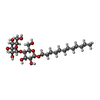
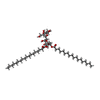

| #31: Sugar | ChemComp-LMT / #34: Sugar | ChemComp-DGD / |
|---|
-Non-polymers , 15 types, 1394 molecules 


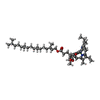

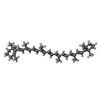
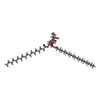
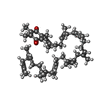
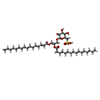
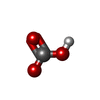
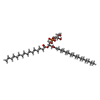


















| #22: Chemical | | #23: Chemical | #24: Chemical | ChemComp-CL / #25: Chemical | ChemComp-CLA / #26: Chemical | ChemComp-PHO / #27: Chemical | ChemComp-BCR / #28: Chemical | ChemComp-LMG / #29: Chemical | ChemComp-PL9 / #30: Chemical | ChemComp-SQD / #32: Chemical | #33: Chemical | ChemComp-LHG / #35: Chemical | ChemComp-HEM / #36: Chemical | ChemComp-CA / #37: Chemical | #38: Water | ChemComp-HOH / | |
|---|
-Details
| Has ligand of interest | Y |
|---|---|
| Has protein modification | Y |
-Experimental details
-Experiment
| Experiment | Method: ELECTRON MICROSCOPY |
|---|---|
| EM experiment | Aggregation state: PARTICLE / 3D reconstruction method: single particle reconstruction |
- Sample preparation
Sample preparation
| Component | Name: Photosystem II / Type: COMPLEX / Entity ID: #1-#21 / Source: NATURAL |
|---|---|
| Source (natural) | Organism:  |
| Buffer solution | pH: 6.8 |
| Specimen | Embedding applied: NO / Shadowing applied: NO / Staining applied: NO / Vitrification applied: YES |
| Vitrification | Cryogen name: ETHANE |
- Electron microscopy imaging
Electron microscopy imaging
| Experimental equipment |  Model: Titan Krios / Image courtesy: FEI Company |
|---|---|
| Microscopy | Model: FEI TITAN KRIOS |
| Electron gun | Electron source:  FIELD EMISSION GUN / Accelerating voltage: 300 kV / Illumination mode: FLOOD BEAM FIELD EMISSION GUN / Accelerating voltage: 300 kV / Illumination mode: FLOOD BEAM |
| Electron lens | Mode: BRIGHT FIELD |
| Image recording | Electron dose: 40.8 e/Å2 / Film or detector model: GATAN K3 (6k x 4k) |
- Processing
Processing
| CTF correction | Type: PHASE FLIPPING AND AMPLITUDE CORRECTION |
|---|---|
| 3D reconstruction | Resolution: 1.93 Å / Resolution method: FSC 0.143 CUT-OFF / Num. of particles: 202844 / Symmetry type: POINT |
 Movie
Movie Controller
Controller





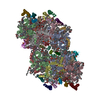
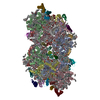
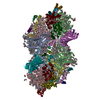
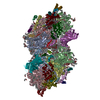
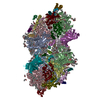
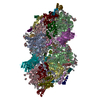

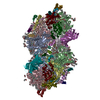
 PDBj
PDBj